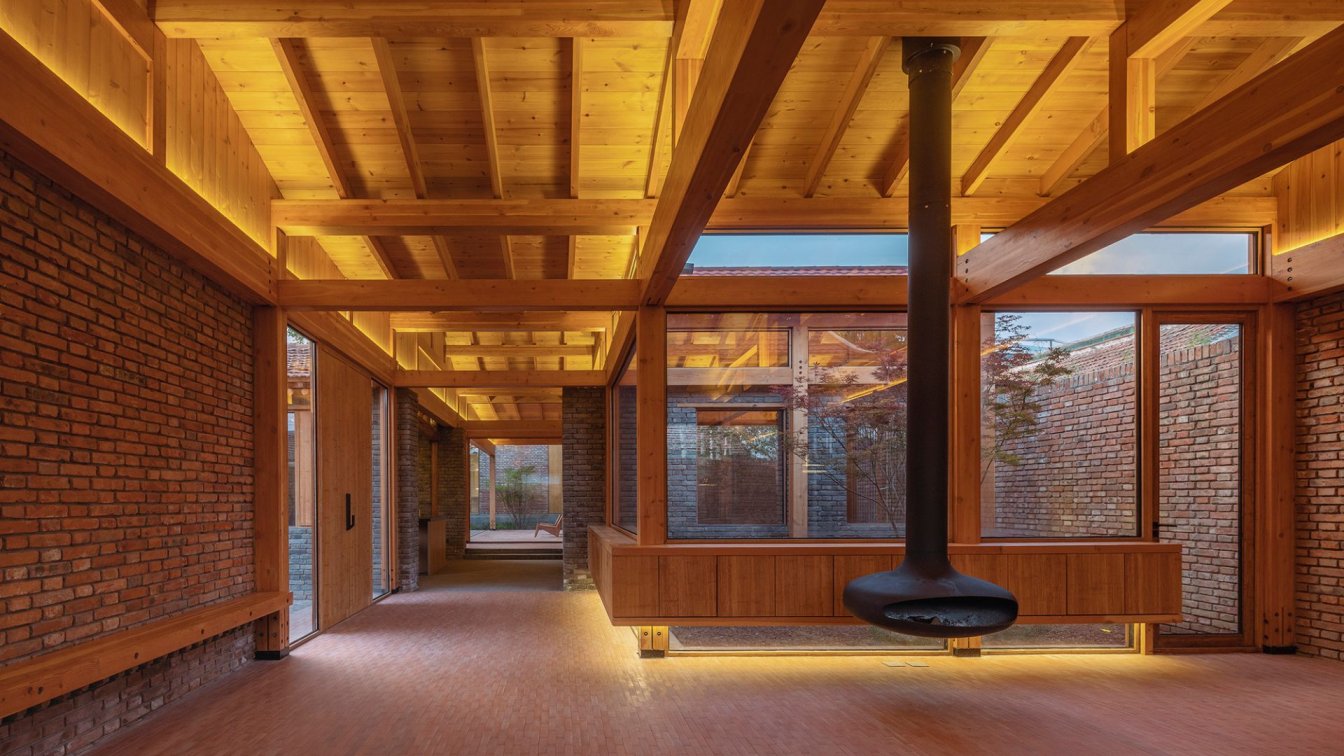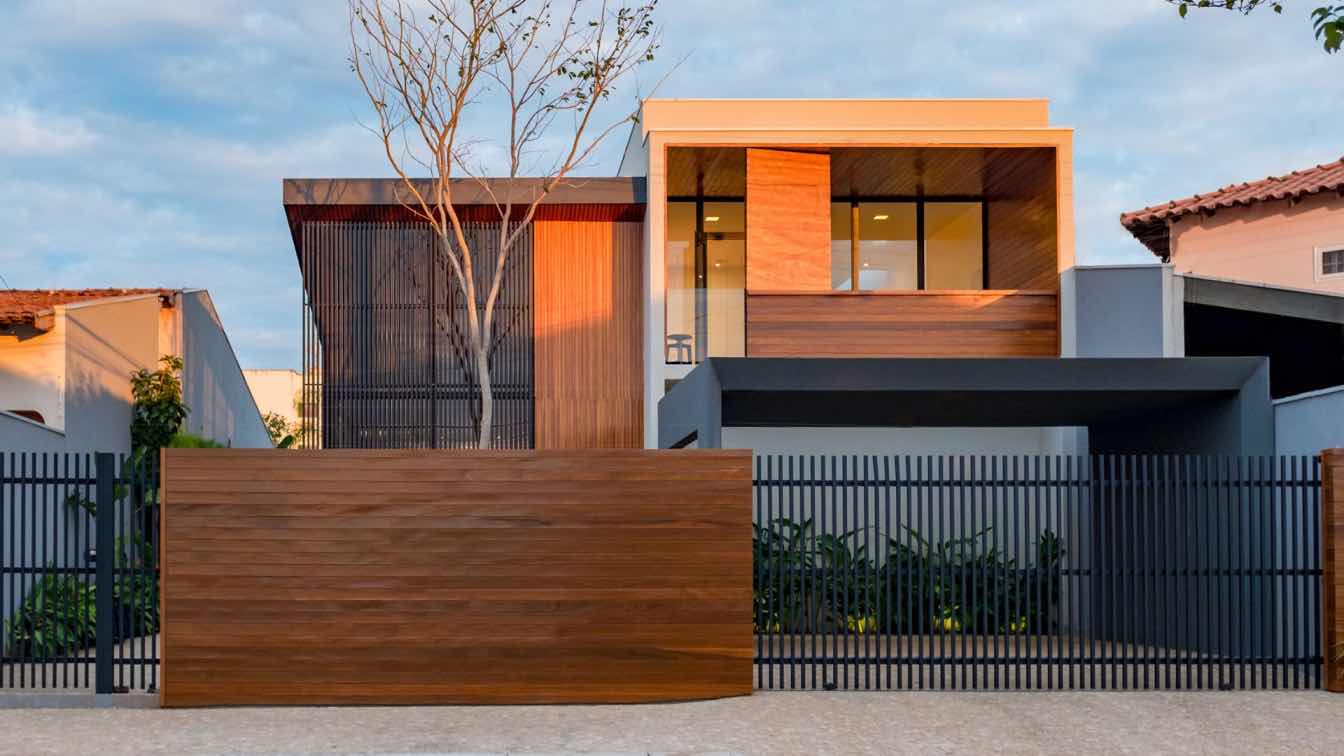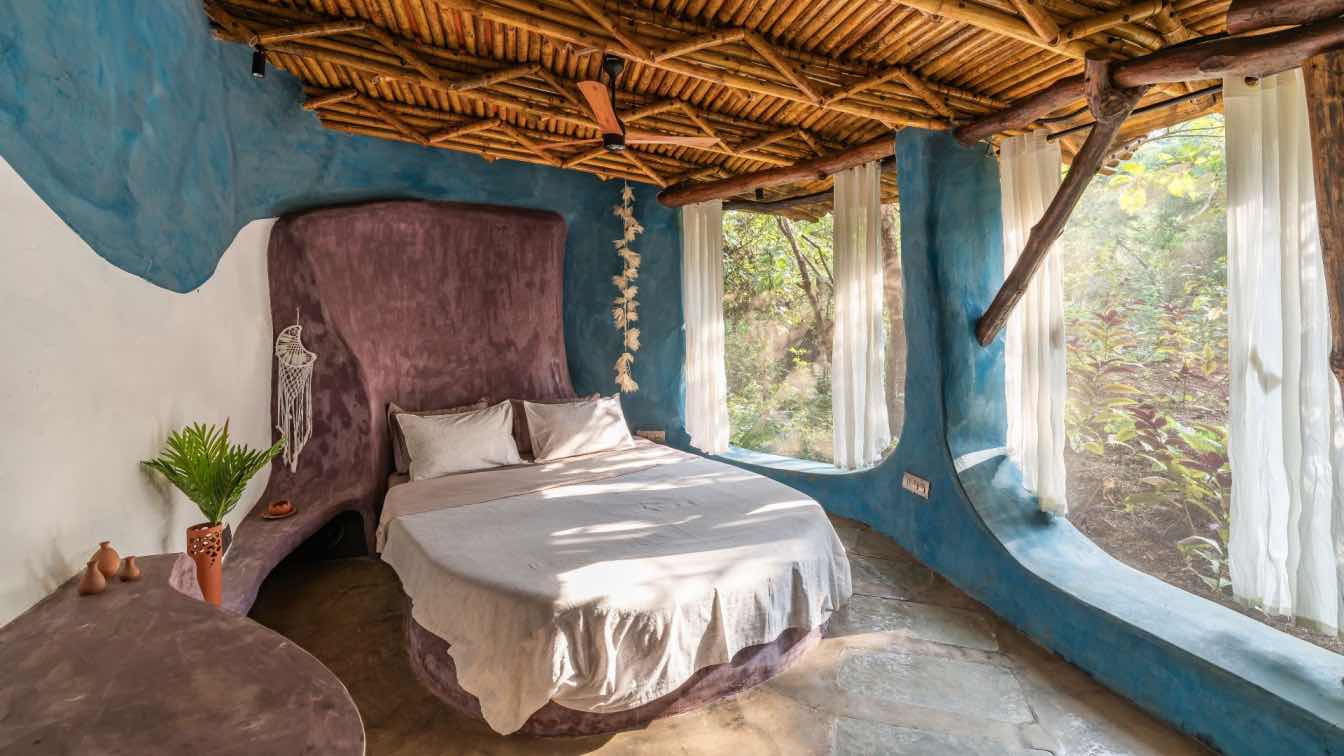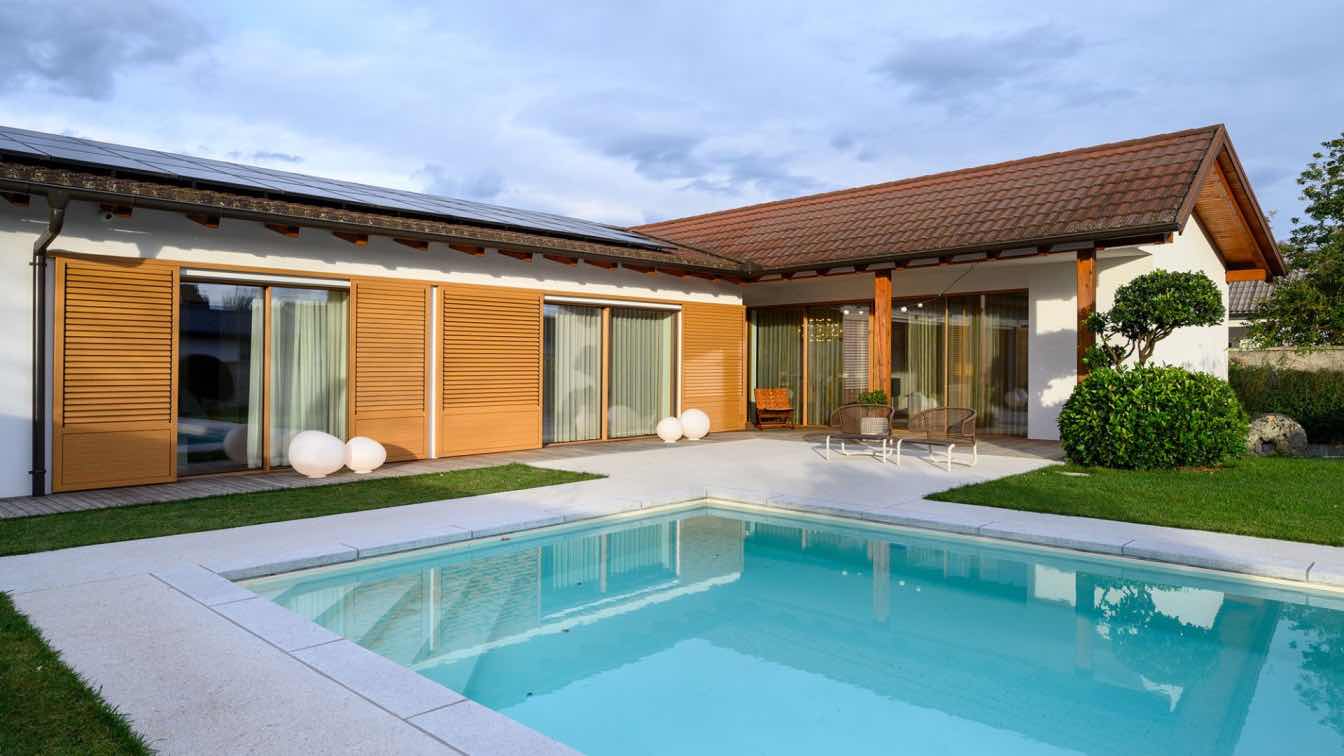ARCHSTUDIO: Courtyard house and village
The project is located in an ordinary village on the outskirts of Beijing, a typical plain-based northern Chinese village mainly composed of one- and two- storey courtyard houses. Most houses in the village face south, and feature red bricks and tiles. Besides, there are also various added constructions built independently by local villagers for meeting their changing living needs, such as shanties with colored-steel roof or glass roof, which blend with the natural fabrics of the village.
The project is the transformation of a courtyard house in the village. The client, who currently lives in the downtown area, hoped to create a family vacation home and a venue for gathering with friends. As approaching this project, ARCHSTUDIO intended to present an architectural status that mixes the old and new, and to build a connection between the project and the built landscape of the village. The goal was to let the renovated architecture integrate into the village with a low-profile gesture, and meanwhile to create a rich and natural small world inside the courtyard house.
Old house and new wooden construction
Mix of architectural forms
The original architecture is a courtyard compound, consisting of two courtyards, two pitched-tile-roof buildings and several flat-roof volumes. After site investigation, the design team decided to retain and properly transform the north building, which were frequently used and were in good structural condition; to renovate and preserve the south building, which had old structures with historical value; and to dismantle other auxiliary volumes built for temporary use.
The new addition is an undulating wooden construction, which replaces the old rooms at the middle of the site and extends to north and south sides to create spaces for daily life use, hence shaping a new pattern for the courtyard compound. The new wooden volume undulates in line with the old roofs, and forms two continuous roof ridges, under which are major public living spaces including living room, dining room and kitchen. In addition, two flat-roof building blocks are extended under the roof of the wooden construction, accommodating ancillary functions including two bedrooms, garage and bathroom. For the old building on the north side, the design team exposed its roof structures, and set two bedrooms and a living room in its interior space. The insertion of the new wooden construction strengthens the undulating layering of the roofs, and creates a dialogue between the old and new building volumes.

Courtyard and interior
Mix of behaviors
The original spatial pattern featuring one front yard and one back yard are reorganized, to form six yards with different scales, landscapes and functions. The front yard is set at the southwest core of the site. Opening the metal gate, a bamboo path leads the occupants to the building entrance. Pushing the door and entering the foyer, a courtyard with a maple tree comes into view. The maple tree displays the colors of nature in different seasons, and becomes a highlighted view between the living room and the dining room. Space set aside between the living room and the south enclosure wall forms a side yard, where trees and stones are set. In sunny days, the folding doors of the living room can be completely opened, to extend the yard into the interior.
Further moving towards the north, the occupants will reach the renovated old building. Here, the kitchen and the dining room unfold horizontally, and the old and new roof structures dialogue with each other. Between the dining room and the walls of a neighbor's house is a bamboo yard, which offers an experience of eating and drinking in a bamboo grove.
After passing through the dining room, the back yard is reached. This yard is mainly for outdoor activities, and is connected with a semi-outdoor veranda. Planted with a big tree, it provides a pleasing place for leisure and chatting.
The space at the back is the bedroom area. The north building and the wooden construction are connected by a glass corridor, which naturally forms a narrow yard. The three bedrooms provide a direct view to the outdoor landscape, satisfy daylighting and ventilation needs, and meanwhile avoid obstructed sight lines. The organization of various yards brings natural vitality into every corner of the interior space.

Structures and materials
Mix of the old and the new
The newly built wooden construction adopts cedar plywood as main material and applies traditional beam-lifted frames, to echo the features of traditional northern Chinese houses. By fully utilizing plywood, a low-carbon and renewable natural building material, the newly inserted wooden construction continues the existing old house's wooden frame with new structural expressions, hence creating a dialogue between the old and the new. Moreover, the undulating new roof is constructed with beams and columns featuring minimized cross sections and maximized spans, to ensure a reasonable structure and control costs.
Doors and windows employ fixed insulating glass and openable frames made of laminated bamboo panels. The solid openable window frames help improve ventilation, and the fixed glass panes provide complete outdoor views. Besides, all indoor fixed furniture pieces are customized with the use of laminated bamboo panels. Various timer materials, including plywood, laminated bamboo and the existing wooden beams, form a fusion of the old and the new.
The newly built enclosure walls are completely made of red and gray old bricks recycled locally, which realizes the reuse of waste materials. When renovating the existing buildings, the design team decided to remove and polish the white ceramic tiles on the exterior of the preserved north building to expose its red-brick walls. As demolishing parts of the south building's roof, the designers found that its original structures were seriously damaged and the walls under it were at the risk of collapse. Therefore, they took the roof apart, and replaced some old wooden components with new ones. Meanwhile, the walls were rebuilt with old gray bricks in consistent with their original forms.
The ground is paved with new red bricks, which perform better in resisting water and dust. Rooftops are clad in red vermiculite-coated metal tiles, which are lightweight, cost-saving and have a long life span. The red surfaces of those metal tiles harmonize with the red roofing tiles commonly seem in the village.
By creating yards, updating structures and reusing materials, the design team tried to invent a sustainable design strategy for the evolution from the old to the new. Besides, they struck a balance in maintaining characteristics, coordinating styles and controlling costs to create new possibilities for the renewal of rural architecture.
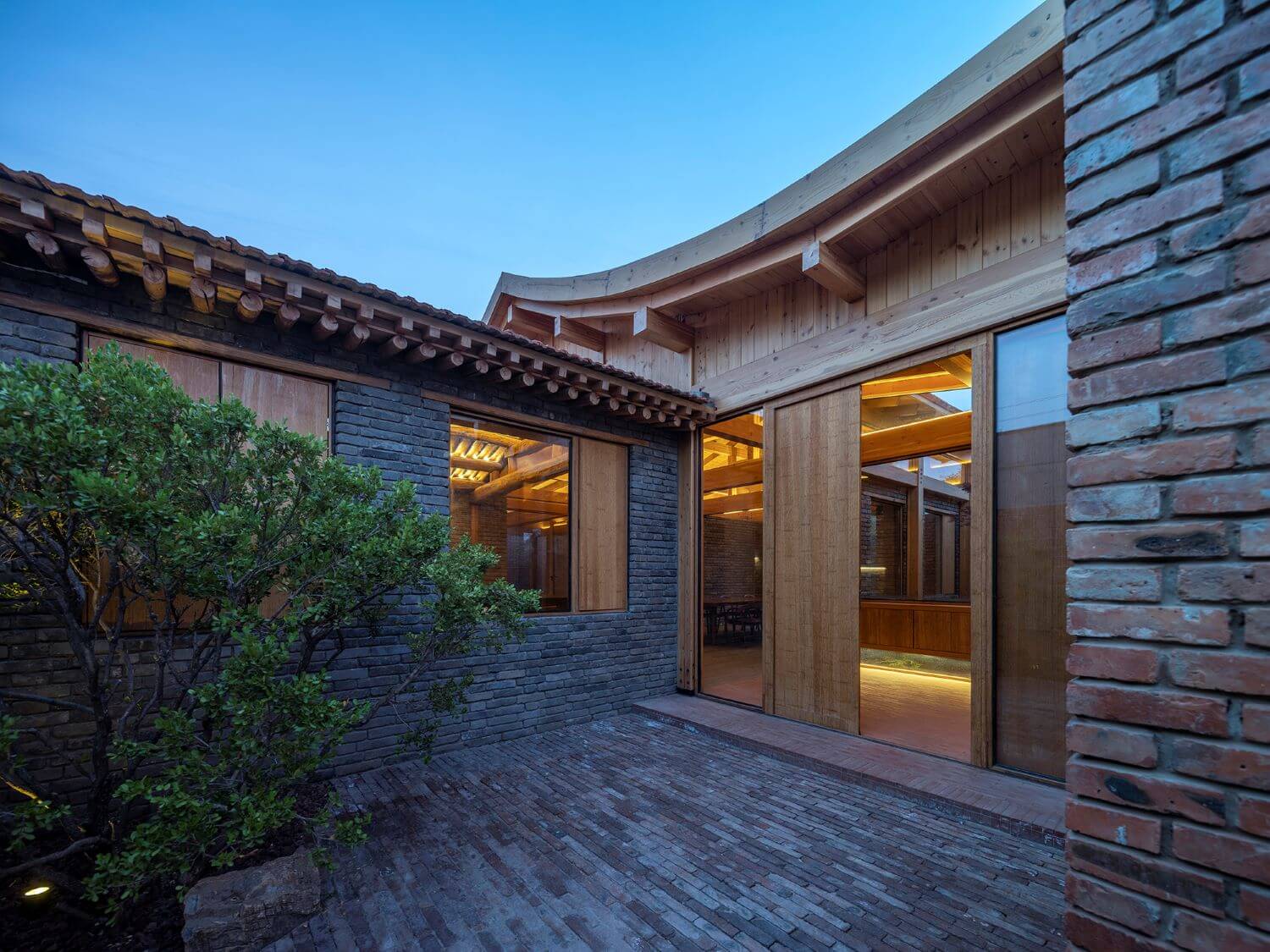






















































ARCHSTUDIO
Established in 2010 and based in 798 Art Zone, Beijing, ARCHSTUDIO advocates maintaining a harmonious balance among human, nature, history and commerce in design practices, pursues the essence and true way of design, controls the whole process from concept to construction, and strives to create quality and emotional spatial environment that is based on the contemporary era and embraces future. Currently, the Studio mainly focuses on architectural design in natural context, urban architecture renovation & transformation, and upgrade of consumption space, etc.
Space is an aggregation of various relationships. During design practices, ARCHSTUDIO insists on the principle of "design of relationships", analyzes reality of uncertainties, and coordinates relations between the large and small, exterior and interior, the new and old, the artificial and natural, etc. Besides, it works to create forms according to physical objects, produce spatial ambience for the mind, evoke interaction between the space and physical behaviors and enable infinite space perception, thereby to enhance spirit and experiences of the space.
In 2015, ARCHSTUDIO was honored as one of the 10 Design Vanguards by the renowned American magazine Architectural Record. And from 2015 to 2019, it has been included in China's AD100 list consecutively from 2015 to 2019, which recognizes it as one of China's top 100 talents in architecture and design.
Han Wenqiang
Associate Professor, School of Architecture of CAFA (Central Academy of Fine Arts)
Founder & Chief Architect, ARCHSTUDIO
Mr. Han Wenqiang advocates the principle of "design of relationships", so as to make the space to be the communication medium, realize the deep link among body, nature, history and man-made environment, thereby shortening the emotional distance between people and environment. His design practice covers old building renewal, architectural and interior design.
He has been invited as a jury for Leaf Awards 2020-2021, Architizer A+Awards 2020 & 2021, Rethinking the Future Awards 2022. And he was a winner of Architectural Record's Design Vanguard Competition, Perspective's 40 UNDER 40 Awards (Architecture category), FA Emerging Architect Award, etc.
Han Wenqiang's representative works mainly include Waterside Buddhist Shrine, Tea House in Hutong, Organic Farm, etc. His has won the LEAF Awards, Architizer A+Awards, Interior Design's Best of Year Awards, ASC Architectural Design Awards, WA Awards for Chinese Architecture, ArchDaily's Building of The Year Awards. He has been invited to participate in many exhibitions at home and abroad, including "Contemporary Architecture in China" at Harvard, "Chinese Construction Heritage" exhibition in Lyon, France and "The 13th National Exhibition of Fine Arts". Besides, his design works have been published by multiple renowned magazines such as Architectural Record, Architectural Review, Arquitectura Viva, Frame, d+a, Perspective, Architectural Journal, Archicreation, World Architecture Review and so on.

